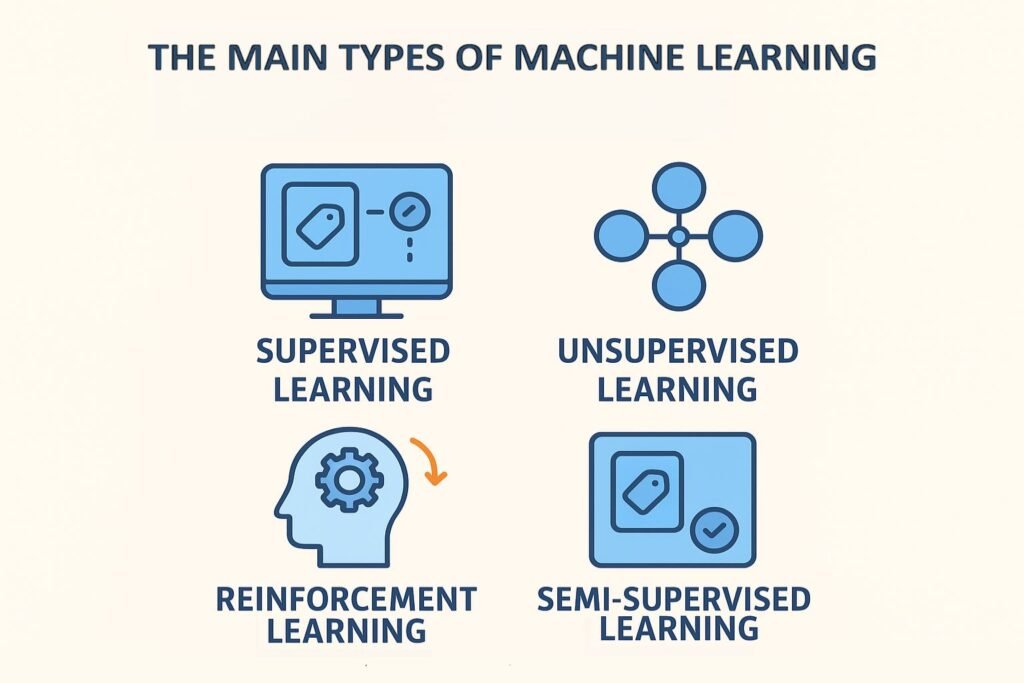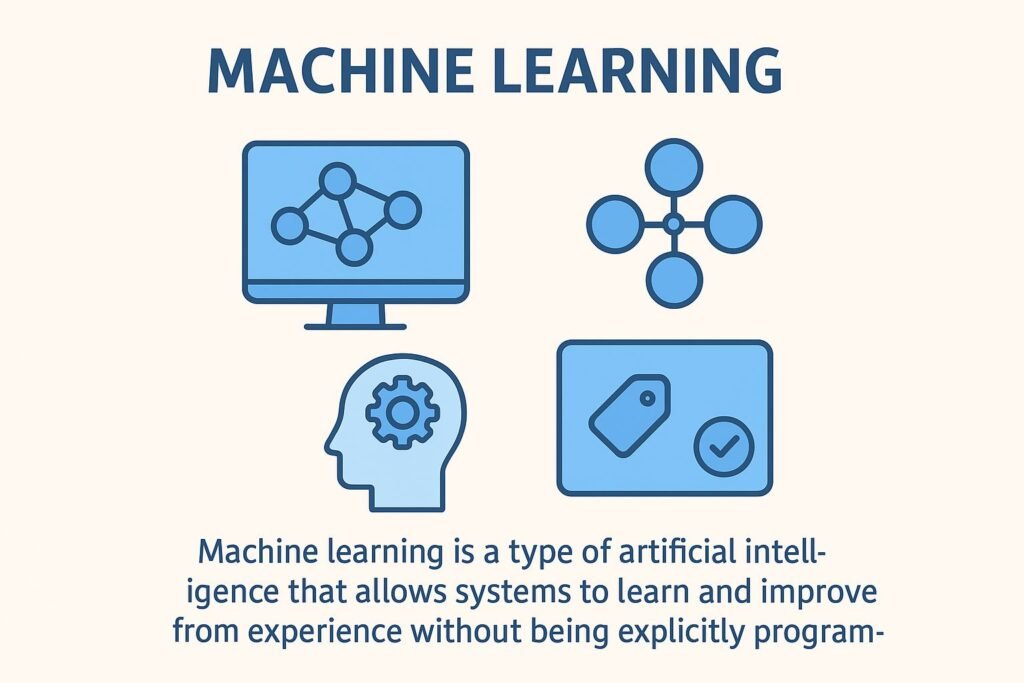The Main Types of Machine Learning Explained
Machine learning (ML) is no longer just a buzzword—it’s the backbone of technologies we use every day. From Netflix recommending your next binge-worthy series to fraud detection systems flagging suspicious bank transactions, ML powers much of the innovation we rely on. But here’s the challenge: whenever people hear machine learning, it sounds like one massive, complex concept. In reality, there are different types of machine learning, each with its own strengths, limitations, and real-world applications.
Understanding these categories is crucial—whether you’re an aspiring data scientist, a business leader evaluating AI strategies, or just a curious tech enthusiast. This guide will not only break down the main types of machine learning but also offer fresh insights and relatable examples you won’t find in generic blogs.
Why Understanding the Types of Machine Learning Matters
Imagine you’re running a café. If you hire a barista, you wouldn’t train them the same way you would a chef or a cashier. Each role requires a unique training style, goals, and performance evaluation.
Machine learning is similar. Depending on the type of data and problem, you’d “train” your ML model differently. Choosing the wrong approach is like teaching a barista how to cook pasta—they’ll be confused, and your customers won’t get what they ordered.
So, let’s unpack the four main types of machine learning you need to know:

- Supervised Learning
- Unsupervised Learning
- Reinforcement Learning
- Semi-Supervised Learning
1. Supervised Learning – Learning with Guidance
Supervised learning is like teaching a child with flashcards. You show them a picture of a cat and say “cat,” then repeat with “dog,” “apple,” or “car.” Over time, they learn to recognize patterns and predict outcomes when faced with new images.
In supervised learning, models train on labeled data—datasets where the inputs (features) and the correct outputs (labels) are already known.
Real-World Examples of Supervised Learning
- Email spam filters: Gmail uses supervised models trained on millions of labeled “spam” and “not spam” emails.
- Loan approval: Banks analyze historical data of approved and denied applicants to predict future creditworthiness.
- Healthcare diagnostics: Models learn from patient records (symptoms + outcomes) to predict diseases.
Advantages
- High accuracy with clean, labeled data.
- Easy to evaluate using metrics like accuracy, precision, or recall.
Limitations
- Requires large amounts of labeled data, which can be expensive and time-consuming to collect.
- Models may overfit—performing well on training data but poorly on unseen cases.
Note: Supervised learning shines when you know what the “correct answer” looks like. Think of it as the GPS of machine learning—it always needs a clear destination.
2. Unsupervised Learning – Finding Hidden Patterns
Unsupervised learning is like dropping a group of strangers into a room and watching how they naturally form cliques—without giving them name tags or roles. The algorithm looks at raw, unlabeled data and tries to uncover hidden structures. “In fact, Scikit-learn’s unsupervised learning models include clustering methods like k-means, which marketers use for customer segmentation.”
Key Techniques
- Clustering: Grouping data based on similarity (e.g., customer segmentation).
- Dimensionality Reduction: Simplifying data without losing critical patterns (e.g., reducing noise in images).
Real-World Examples of Unsupervised Learning
- Customer segmentation in marketing: Identifying clusters of “budget shoppers,” “brand loyalists,” and “impulse buyers.”
- Anomaly detection in cybersecurity: Spotting unusual patterns that may indicate fraud or malware.
- Recommendation engines: Grouping similar users and products to suggest “people who bought this also bought…”
Advantages
- Doesn’t need labeled data—useful when labels are unavailable or costly.
- Excellent for discovering patterns humans might overlook.
Limitations
- Results can be ambiguous (e.g., deciding how many clusters are “right”).
- Harder to evaluate compared to supervised learning.
Finally, Unsupervised learning is often underestimated. It’s not about predicting outcomes but about exploration. If supervised learning is like teaching with answers, unsupervised learning is about asking, “What story is this data trying to tell me?”
3. Reinforcement Learning – Learning by Trial and Error
Reinforcement learning (RL) is arguably the most exciting type of machine learning. Imagine training a dog: you give it a treat for sitting on command, but ignore it when it barks unnecessarily. Over time, it learns to maximize rewards and minimize penalties.
In RL, an agent interacts with an environment, makes decisions, and learns from feedback (rewards or punishments).
Real-World Examples of Reinforcement Learning
- Self-driving cars: Learning when to accelerate, brake, or change lanes based on road conditions.
- Robotics: Teaching robots to grasp objects or walk smoothly.
- Gaming: AlphaGo and other AI systems that outperformed humans in complex strategy games. “Breakthroughs like AlphaGo from DeepMind highlight the power of reinforcement learning in mastering complex games.”
Advantages
- Effective for complex, sequential decision-making problems.
- Learns dynamically from real-time interactions.
Limitations
- Requires massive computational power.
- High risk of unintended behaviors if the “reward system” is poorly designed.
Insight: RL is the frontier of AI. While supervised and unsupervised learning often deal with static data, RL thrives in dynamic, changing environments. It’s less about memorizing patterns and more about learning how to act.
4. Semi-Supervised Learning – The Best of Both Worlds
Semi-supervised learning sits between supervised and unsupervised learning. It uses a small amount of labeled data alongside a large pool of unlabeled data.
Think of it like a classroom where a teacher provides guidance for a few examples, and then students figure out the rest by collaborating and exploring.
Real-World Examples of Semi-Supervised Learning
- Speech recognition: Labeled audio clips are scarce, but unlabeled recordings are abundant. Semi-supervised models can leverage both.
- Medical imaging: A handful of labeled scans (with doctor annotations) can guide analysis of thousands of unlabeled images. “Researchers at MIT are advancing semi-supervised methods to handle limited labeled medical data effectively.”
- Web content classification: A few labeled articles help classify massive amounts of unlabeled text.
Advantages
- Cuts down the cost and effort of labeling massive datasets.
- Often achieves higher accuracy than purely unsupervised learning.
Limitations
- More complex to design than purely supervised or unsupervised models.
- Risks of propagating errors if the initial labeled data is biased or flawed.
Fresh Perspective: Semi-supervised learning is becoming increasingly relevant in today’s data-driven world, where unlabeled data is abundant, but labeling it remains expensive.
Comparison – Types of Machine Learning
| Type | Training Data | Goal | Example Use Case | Key Challenge |
|---|---|---|---|---|
| Supervised Learning | Labeled | Predict outcomes | Spam detection, loan approval | Needs lots of labeled data |
| Unsupervised Learning | Unlabeled | Discover hidden patterns | Customer segmentation | Hard to evaluate results |
| Reinforcement Learning | Trial & Error | Learn optimal actions | Self-driving cars, gaming | Computationally expensive |
| Semi-Supervised | Few labeled + many unlabeled | Balance prediction + discovery | Medical imaging, speech recognition | Risk of error propagation |
Choosing the Right Type of Machine Learning
Here’s a simple way to decide:
- Have labeled data? → Go for supervised learning.
- No labels, but want insights? → Choose unsupervised learning.
- Need to learn actions in real time? → Use reinforcement learning.
- A mix of limited labels and large unlabeled data? → Opt for semi-supervised learning.
Key Takeaways
- Supervised learning is best when you already know the answers.
- Unsupervised learning uncovers patterns you didn’t know existed.
- Reinforcement learning thrives in environments where decisions evolve.
- Semi-supervised learning leverages the best of both labeled and unlabeled data.

Big Picture: Think of these types as tools in a toolbox. The smartest data scientists don’t stick to just one—they mix and match depending on the problem.
Conclusion
Machine learning isn’t one-size-fits-all. The types of machine learning—supervised, unsupervised, reinforcement, and semi-supervised—each bring unique strengths to the table. Whether it’s detecting fraud, teaching robots, or personalizing customer experiences, the right approach can make or break your AI project.
As you explore the ML landscape, remember: it’s less about memorizing definitions and more about understanding the “why” and “when” behind each method. That’s how you’ll move from theory to impact.



